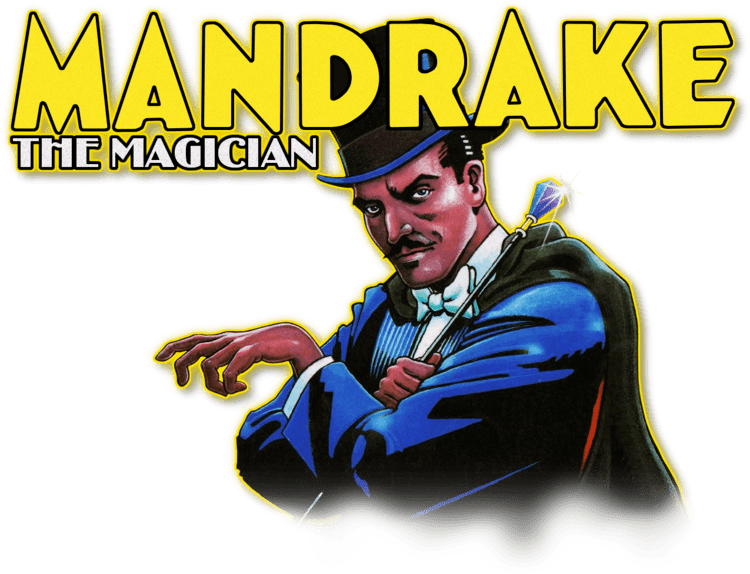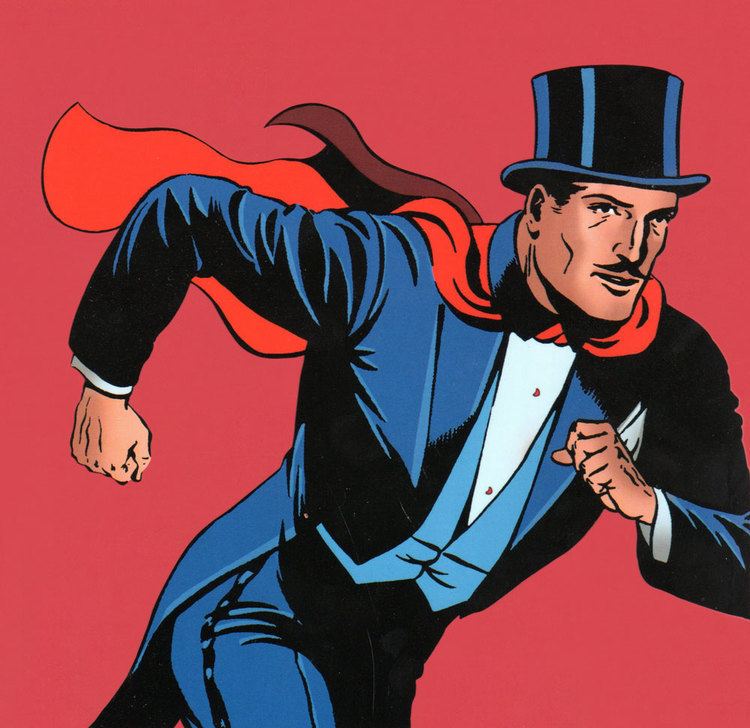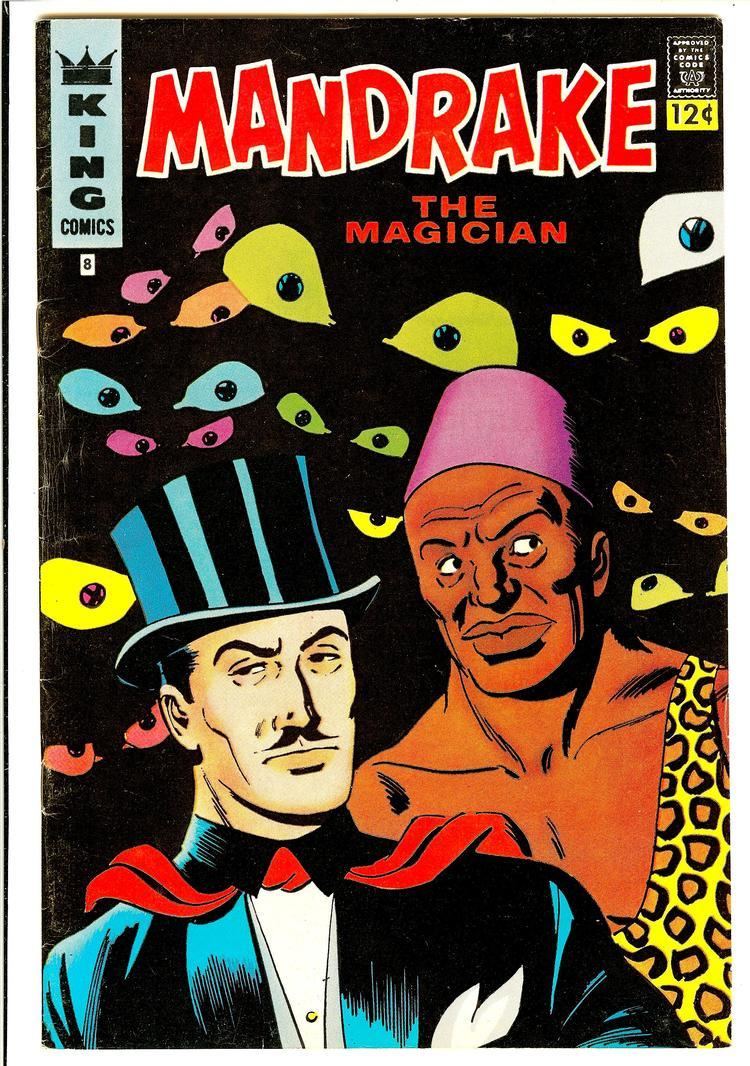First appearance June 11, 1934 | ||
Abilities Master magicianExtended lifespanGenius-level intellect Similar The Phantom, Prince Valiant, Rip Kirby, The Katzenjammer Kids, Beetle Bailey | ||
Mandrake the Magician is a syndicated newspaper comic strip, created by Lee Falk (before he created The Phantom). Mandrake began publication on June 11, 1934. Phil Davis soon took over as the strip's illustrator, while Falk continued to script. The strip is distributed by King Features Syndicate.
Contents
- Characters and story
- Supporting
- Villains
- Comic books
- Radio
- Films
- Unproduced films
- Television
- Theater
- Parodies and tributes
- Leon Mandrake
- Reprints
- In popular culture
- References

Mandrake, along with the Phantom Magician in Mel Graff's The Adventures of Patsy, are regarded by comics historians as the first superheroes of comics. Comics historian Don Markstein writes, "Some people say Mandrake the Magician, who started in 1934, was comics' first superhero."
Davis worked on the strip until his death in 1964, when Falk recruited current artist Fred Fredericks. With Falk's death in 1999, Fredericks became both writer and artist. The Sunday Mandrake strip ended December 29, 2002. The daily strip ended mid-story on July 6, 2013 when Fred Fredericks retired, and a reprint of D220 "Pursuit of the Cobra" from 1995 began on July 8, 2013.

Characters and story

Mandrake is a magician whose work is based on an unusually fast hypnotic technique. As noted in captions, when Mandrake "gestures hypnotically", his subjects see illusions, and Mandrake has used this technique against a variety of villains including gangsters, Mad scientists, extraterrestrials, and characters from other dimensions. At various times in the comic strip, Mandrake has also demonstrated other powers, including turning invisible, shapeshifting, levitation, and teleportation. His hat, cloak and wand, passed down from his father Theron, possess great magical properties which in time Mandrake learns how to use. Although Mandrake publicly works as a stage magician, he spends much of his time fighting criminals and combatting supernatural entities. Mandrake lives in Xanadu, a high-tech mansion atop a mountain in New York State. Xanadu's features include closed circuit TV; a sectional road which divides in half; and vertical iron gates.
Supporting

Lothar is Mandrake's best friend and crimefighting companion. Mandrake first met Lothar during his travels in Africa. Lothar was "Prince of the Seven Nations", a mighty federation of jungle tribes; but forbore to become king and instead followed Mandrake on his world travels. Lothar is often referred to as "the strongest man in the world", with the exception of Hojo — Mandrake's chef and secret chief of Inter Intel. Lothar is invulnerable to any weapon forged by man, impervious to heat, cold and possesses the stamina of a thousand men. He also cannot be harmed by magic directly (fire bolts, force bolts, spell incantations). He can lift an elephant by one hand easily.

One of the first African crimefighting heroes ever to appear in comics, Lothar made his First appearance alongside Mandrake in 1934 in the inaugural daily strip. In the beginning, Lothar spoke poor English and wore a fez, short pants, and a leopard skin. In a 1935 work by King Features Syndicate, Lothar is referred to as Mandrake's "giant black slave." When artist Fred Fredericks took over in 1965, Lothar spoke correct English and his clothing changed, although he often wore shirts with leopard-skin patterns.

Narda is Princess of the European nation Cockaigne (ruled by her brother Segrid). She made her first appearance in the second Mandrake story. Although she and Mandrake were infatuated with one another, they did not marry until 1997, which occurred at an extravagant triple wedding ceremony—at Mandrake's home of Xanadu, Narda's home country Cockaigne, and Mandrake's father Theron's College of Magic (Collegium Magikos) in the Himalayas. Narda learned martial arts from Hojo.

Theron is the headmaster of the College of Magic (Collegium Magikos) located in the Himalayas. Theron is hundreds of years old and may be kept alive by the Mind Crystal of which he is the guardian.
Hojo is Mandrake's chef at his home of Xanadu, and the secret Chief of the international crimefighting organization Inter-Intel, in addition to being a superb martial arts expert. As such, he has used Mandrake's help with many cases. Hojo's assistant at Inter-Intel is Jed. Hojo knows 6 languages.
The Police Chief is named Bradley but mostly called "Chief" and has been aided by Mandrake on several occasions. He created the "S.S.D." (Silly Stuff Dept.) for absurd and unbelievable cases that only Mandrake could solve. He has a son, Chris.
Magnon is Mandrake's most powerful friend and the emperor of the galaxy. Magnon and his wife Carola have a daughter, Nardraka, who is named after Mandrake and Narda and is their godchild.
Lenore is Mandrake's younger half-sister. She is a world-renowned explorer.
Karma is Lothar's girlfriend, an African princess who works as a model.
Villains
The Cobra is Mandrake's most evil and dangerous foe, apparent from the start of the story. In 1937, the Cobra was apparently defeated; but returned in 1965, wearing a menacing silver mask. The Cobra's main goal is to acquire one of the two powerful Crystal Cubes which increase mental energy. These are guarded by Mandrake and his father Theron. Mandrake learned that The Cobra was secretly Luciphor, Theron's oldest son and thus Mandrake's half-brother. In later years, the Cobra abandoned his silver mask as his face had been reconstructed through surgery. He is sometimes accompanied by his assistant Ud.
Derek is Mandrake's twin brother, he was similar to Mandrake in appearance, used his magical powers (nearly the equal of Mandrake's) to achieve short-term personal satisfactions. Mandrake has tried to remove Derek's knowledge of magic; but has never entirely succeeded. Derek has a son, Eric (mother unknown), who has shown no signs of following in his father's footsteps.
The Clay Camel, real name Saki, is a master of disguise, able to mimic anyone and change his appearance in seconds. His name comes from the symbol he leaves at the scenes of his crimes, a small camel made of clay.
The Brass Monkey, daughter of the Clay Camel, with a similar talent for disguises.
Aleena the Enchantress is a former friend of Mandrake's from the College of Magic, a much-married spoilt temptress who uses her magic powers for her own benefit. She sometimes attempts to seduce Mandrake; but fails, and thereafter attempts to cause him trouble.
8 is an old and very powerful crime organization originating in medieval times. They are known to often incorporate the number 8 in their crimes or leave the number 8 as a mark. They are organized like an octopus with eight arms (headquarters) spread all over the world, and one head (the mysterious leader Octon, only shown as a menacing image on a computer screen). Over the years, Mandrake destroys their headquarters one by one. In one of the stories the Octon of 8 is revealed as Cobra; but the name later referred to an artificial intelligence wielded by Ming the Merciless in the television series Defenders of the Earth.
Ekardnam ('Mandrake' backwards) is Mandrake's "evil twin", who exists on the other side of the mirror. Like his world (where the government is run by the "Private of the Armies", and generals do menial work), Ekardnam is an exact opposite, and uses his "evil eye" to work his magic.
The Deleter is an extraterrestrial contract killer who will "delete" anyone for a price, but will inflict justice on anyone who tries to cheat him out of his contract fee.
Nitro Cain a mad bomber who threw sticks of explosives at people, including Mandrake. The Mandrake comic strip appeared in the Australian newspaper "Sunday Telegraph. The series was abrupty withdrawn with the last panel showing that Nitro Cain had blown Mandrake off a horse, with Mandrake exclaiming "Blast you, Nitro Cain", a clever reference to the explosive's blast.
Comic books
Mandrake had a prominent role in Magic Comics and Big Little Books of the 1930s and 1940s. Dell Comics published a Mandrake the Magician issue in their Four Color comic series with various main characters. The Mandrake issue was #752 and featured original stories by Stan Campell and written by Paul Newman.
In 1966–67, King Comics published ten issues of a Mandrake the Magician comic book. Most of the stories were remakes of past newspaper strip stories and featured art by André LeBlanc, Ray Bailey and others. Mandrake stories also ran as back-up features in other King titles.
Italian publisher Fratelli Spada produced a considerable amount of original Mandrake comic book stories in the 1960s and 1970s. A few of these were even published in the American Mandrake comic book mentioned above.
Marvel released a Mandrake mini-series in 1995, written by Mike W. Barr and with painted art by Rob Ortaleza. However, only two of three planned issues were published.
Mandrake has also enjoyed great success in comic books published in Britain, Australia, Brazil, India, France, Spain, Italy, Yugoslavia, Germany, Norway, Denmark, Finland, Turkey and Sweden (although in the case of the Nordic countries, most often as a backup feature in The Phantom comic books). Mandrake is popular in India through Indrajal Comics.
Mandrake is featured together with the Phantom in The Phantom Annual #2, written by Mike Bullock and Kevin Grevioux and published by Moonstone Books.
In 2013, Dynamite Entertainment launched a mini-series, Kings Watch, where (much like Defenders of the Earth), Mandrake and Lothar teamed up with the Phantom, as well as Flash Gordon, Dale Arden and Hans Zarkov. This series pitted the six characters against the Cobra and Ming the Merciless. This was followed by a Mandrake solo comic, written by Roger Langridge and drawn by Jeremy Treece, as part of Dynamite's King: Dynamite series.
Radio
On radio Mandrake the Magician was a 15-minute radio serial aired on the Mutual Broadcasting System from November 11, 1940, until February 6, 1942.
Films
In 1939, Columbia produced a 12-part Mandrake the Magician serial, based on the King Features strip, starring Warren Hull as Mandrake and Al Kikume as Lothar. The serial is available on DVD.
An unauthorized Mandrake movie produced in Turkey was made in 1967, Mandrake Killing'e karsi (Mandrake against Killing), directed by Oksal Pekmezoglu and starring Güven Erte as Mandrake.
Anthony Herrera had the title role in the TV movie Mandrake (1979) with Ji-Tu Cumbuka as Lothar. Magician Harry Blackstone Jr. was featured in the cast.
In 2007, it was announced that Baldwin Entertainment Group and Hyde Park Entertainment purchased rights to make a Mandrake movie, to be directed by Mimi Leder. The two companies own the rights to Lee Falk's The Phantom. Jonathan Rhys Meyers was originally on board the project as the title character with Chuck Russell announced as director. In 2009, Hayden Christensen replaced Rhys Meyers in the title role of the film, with Djimon Honsou co-starring and Mimi Leder directing. Warner Bros announced that they are developing the film version of Mandrake. In June 2016, Sascha Baron Cohen was cast as Mandrake.
Unproduced films
In the 1960s, Federico Fellini, a close friend of Falk, intended to make a Mandrake movie, but the project never got off the ground.
In the early 1980s, within two weeks of signing with his first agent, American filmmaker Michael Almereyda was hired by Embassy Pictures to rewrite a script for Mandrake the Magician. He told Filmmaker that upon receiving the assignment, he flew to New York and checked himself into the Chelsea Hotel to work on the rewrite. Three weeks later, he emerged with new draft in hand, but by then the studio had changed heads, and in as little time as his revision took, the project was dropped.
Television
NBC made a pilot for a Mandrake the Magician TV series in 1954, but no other episodes were made. Stage magician Coe Norton starred as Mandrake and Woody Strode as Lothar.
Mandrake and Lothar first appeared in animated form with the Phantom, Flash Gordon, and Steve Canyon in the 1972 television special, The Man Who Hated Laughter.
In the animated series Defenders of the Earth (1986–87), Mandrake the Magician teams with fellow King Features adventurers Flash Gordon and The Phantom. Mandrake's best friend and crime fighting partner Lothar also has a prominent role, as well as a teenage son nicknamed L.J. (Lothar Jr.) who was also a martial artist. Mandrake has an adoptive son of Asian blood named Kshin, whom he is training as his apprentice and heir. Peter Renaday provided the voice of Mandrake and Buster Jones provided that of Lothar. The entire series has been released by BCI Eclipse in two DVD sets.
In the animated series Phantom 2040, featuring a future Phantom, Mandrake appears in the episode "The Magician," he is not named in the episode, and is presented as an old friend of that Phantom's father, a magician who helped build a lot of the previous Phantom's equipment. His remarkably well-preserved shape is compatible with the longevity-conferring properties of the Crystals. Peter Renaday once again provides the voice of Mandrake.
Theater
The musical Mandrake the Magician and the Enchantress was produced during the late 1970s at the Lenox Arts Festival in Massachusetts. The script is by Falk and Thayer Burch, with music by George Quincy and lyrics by Burch.
Mandrake is a character in the play King Kong Palace, written by Chilean playwright Marco Antonio de la Parra. In the play, Mandrake is now a performer in birthday parties and attempts to seduce Jane, the ambitious wife of Tarzan, in order to satisfy his lust for power.
Parodies and tributes
Mandrake the Magician inspired several other comic characters with magic powers, including Zatara, Kardak the Mystic Magician, Monako, Dakor the Magician, Ibis the Invincible, Mantor the Magician, Sargon the Sorcerer, Mr. Mystic, The Wizard, Mysto, Magician Detective, and the short-lived Jim the Magician (Jadugar Jim in Hindi) by [Sudhir Tailang] in India.
In Mad #14 (August 1954), Mandrake was spoofed as "Manduck". He lives in a city dump, which he convinces visitors is a palatial home by "gesturing hypnotically". In this story, he matches wits with The Shadow; he, Lothar (called "Loathar"), and The Shadow all gesture hypnotically at each other and after a huge explosion only Lothar (looking like Manduck) remains. In another issue, Manduck pulls off the trick of turning Loathar into a six-foot-tall blonde woman.
"In Pictopia" (first published in Anything Goes! #2, August 1986) is a short story by Alan Moore and illustrator Don Simpson, which takes place in a limbo world of comic book characters. The main character, Nocturno the Necromancer, is based on Mandrake. The story was reprinted in George Khoury's The Extraordinary Works of Alan Moore (TwoMorrows, July 2003)
Michael Kupperman's Tales Designed to Thrizzle, pokes fun at many comics, including Mandrake the Magician with a three-panel strip, "Mancake the Magician".
Leon Mandrake
Leon Mandrake, a stage magician who had been performing for well over ten years before Lee Falk introduced the comic strip character, and who was likewise known for his top hat, pencil line mustache and scarlet-lined cape, is sometimes thought to have been the basis for the origin of the strip. In actuality, he had changed his stage name to Mandrake to match the popular strip, and then legally changed his surname from Giglio to Mandrake later. The resemblance between the comic strip hero and the real life magician was close enough to allow Leon to at least passively allow the illusion that the strip was based on his stage persona. Leon Mandrake was accompanied by Narda, his first wife and stage assistant, named after a similar character who appears in the strip. Velvet, his replacement assistant and eventual life-time partner, would also later make appearances in the strip along with his real-life side-kick, Lothar.
Reprints
In popular culture
Serbian alternative rock band Disciplina Kičme has a song called "Betmen, Mandrak, Fantom" (Batman, Mandrake, Phantom).
New Zealand born Australian country-western sing Tex Morton had a successful song "Mandrake" recorded in 1941. It was about a rodeo horse 'Mandrake' who never bucked the same, "Mandrake is a wizard so that's how he got his name".
In Italy, a popular saying "non sono mica Mandrake" (i.e. "I'm no Mandrake", meaning "I can't do what's impossible") refers to the magician.
